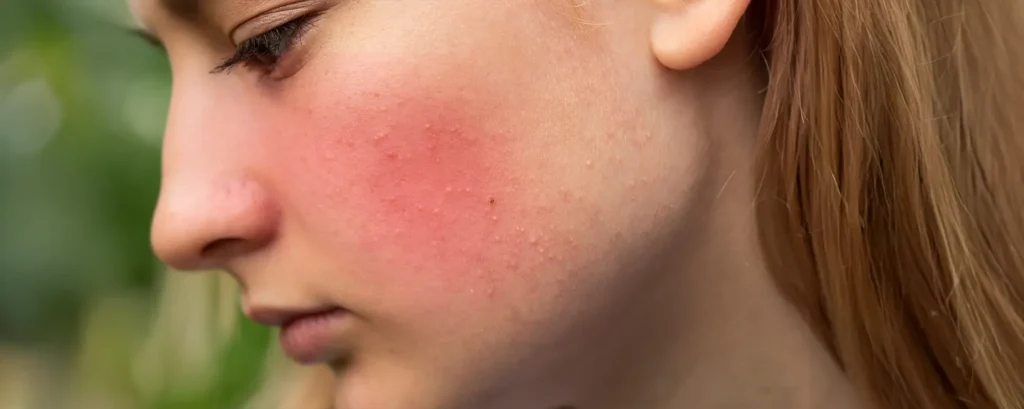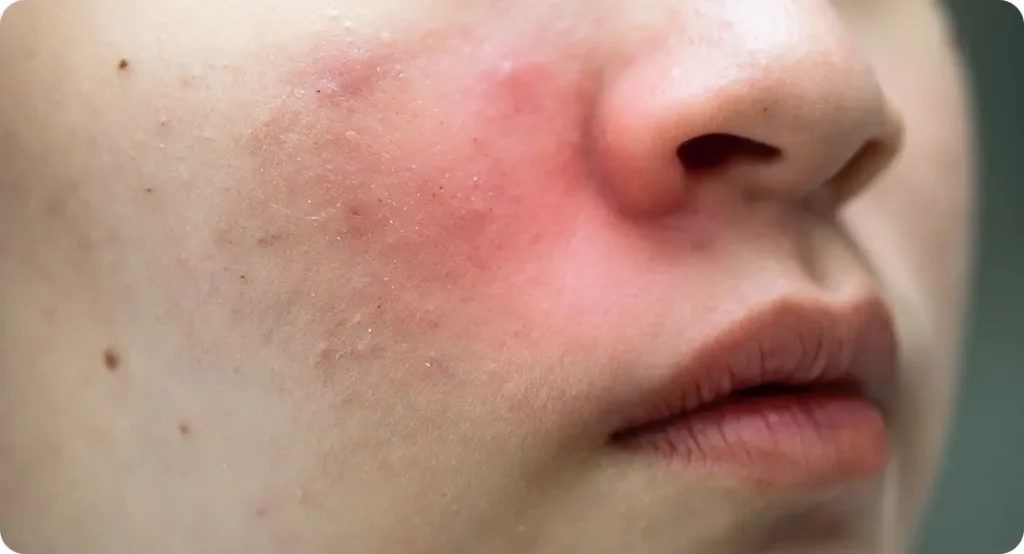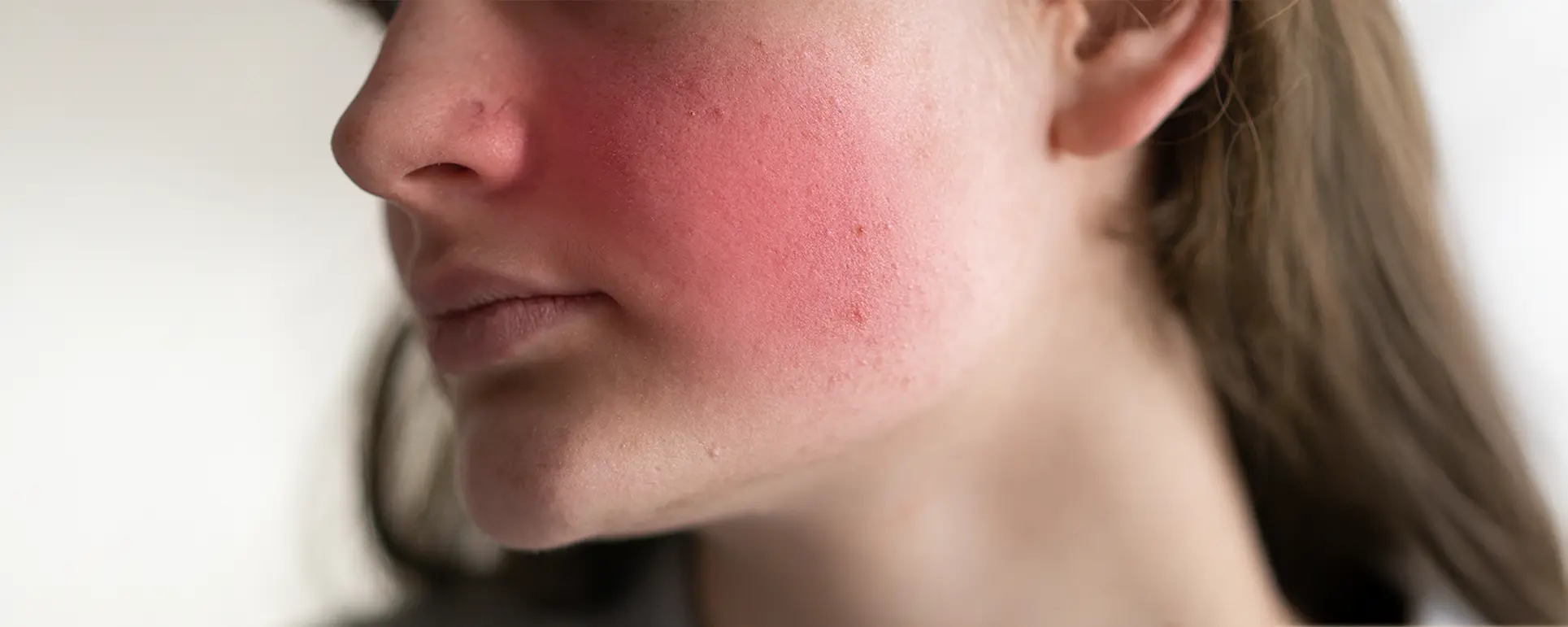Waking up with a flushed or red face can be alarming, especially if it seems to happen every morning. For some, this redness is mild and disappears within a few minutes, but for others, it can be persistent, leaving the skin feeling warm, tight, or even itchy. While occasional facial redness is usually harmless, consistent morning flushing may point to underlying causes that deserve attention.
Facial redness can stem from a variety of factors. Skin conditions like rosacea, eczema, or psoriasis often cause inflammation, resulting in a red, blotchy, or irritated complexion. Even seemingly minor issues such as dry skin, sensitivity to certain skincare products, or reactions to laundry detergents and pillow fabrics can trigger redness. Environmental factors such as temperature changes, low humidity, or exposure to allergens during the night may also aggravate the skin.
Lifestyle choices can play a significant role as well. Alcohol, caffeine, and spicy foods can dilate blood vessels, while stress and lack of sleep may weaken the skin’s natural barrier, making it more susceptible to irritation. Nighttime routines that include heavy creams, oils, or harsh cleansers can sometimes contribute to morning redness by over-stimulating sensitive skin. Even simple habits, like sleeping on your stomach with your face pressed into the pillow, can create temporary pressure-induced redness.
Understanding the reasons behind morning facial redness is crucial to addressing it effectively. By identifying triggers whether they are medical, environmental, or lifestyle-related you can take steps to protect and soothe your skin. Simple adjustments to your bedtime routine, using gentle skincare products, improving sleep quality, and maintaining proper hydration can all help reduce redness over time. In some cases, professional advice from a dermatologist may be necessary to manage persistent or severe redness.
With the right approach, it’s possible to calm your skin, reduce morning redness, and wake up feeling more comfortable and confident in your complexion. By paying attention to both internal and external factors, you can create a routine that supports long-term skin health and prevents redness from becoming a recurring problem.
Common Causes of Morning Facial Redness

1. Rosacea
Rosacea is a chronic inflammatory skin condition that primarily affects the central part of the face, including the cheeks, nose, chin, and forehead. It often presents as persistent redness, flushing, visible blood vessels, and sometimes small, pus-filled bumps. Many people notice that their rosacea flares up in the morning because the skin can become more sensitive overnight. Common triggers include heat, stress, spicy foods, alcohol, and certain skincare products with fragrances or harsh ingredients. Even small irritants, like a new night cream or cleanser, can provoke a reaction. Since rosacea is chronic, redness may be a regular occurrence rather than an isolated event. Identifying personal triggers, avoiding irritants, and using gentle, calming skincare products are essential steps for managing morning redness caused by rosacea.
2. Dry or Dehydrated Skin
Overnight, the skin naturally loses water through a process called transepidermal water loss. If the skin is already dry or lacks proper hydration, this loss can lead to tightness, itchiness, and visible redness in the morning. Harsh cleansers, hot showers, or skipping moisturiser before bed can strip the skin of natural oils, worsening the problem. In addition, sleeping in a dry environment such as rooms with central heating or air conditioning can exacerbate dehydration. Using a rich, non-irritating night cream, applying a hydrating serum, or sleeping with a humidifier can help maintain the skin’s moisture barrier and reduce morning redness.
3. Allergic Reactions
Allergies are a common, but often overlooked, cause of facial redness. Pillowcases washed in strongly scented detergents, pet hair, dust mites, or residues from skincare products can irritate sensitive skin. Even certain foods eaten before bed like dairy, nuts, or highly processed snacks can trigger mild inflammatory responses in some people. Signs of an allergic reaction may include redness, itching, swelling, or small bumps appearing on the face by morning. To identify potential allergens, try switching to hypoallergenic pillowcases, fragrance-free skincare products, or eliminating common food triggers. Keeping the bedroom clean and free of dust can also reduce the likelihood of morning redness caused by allergies.
4. Sleeping Habits
The way you sleep can have a significant impact on your skin. Pressing your face against a pillow while sleeping on your stomach or side can increase blood flow to the skin in contact areas, leading to temporary redness. Heat and sweat trapped under heavy bedding or warm pajamas may also aggravate sensitive skin overnight. Over time, repetitive pressure on the same areas of the face can even contribute to long-term irritation or broken capillaries. Simple adjustments like sleeping on your back, using breathable bedding, or keeping your bedroom cool can help reduce morning facial redness caused by sleeping habits.
5. Environmental Factors
Your sleeping environment plays a crucial role in skin health. Dry air, especially in winter or in air-conditioned rooms, can dehydrate the skin, leaving it prone to irritation and redness. Dust, pollen, and other allergens in the bedroom can trigger inflammatory reactions in sensitive individuals. Sudden temperature changes, such as moving from a warm bed to a cooler room in the morning, can also cause blood vessels to expand, creating a flushed appearance. Taking measures like using a humidifier, washing bedding regularly, and ensuring good ventilation can help create a skin-friendly environment that minimises morning redness.
6. Nighttime Skincare Products
Sometimes, the very products designed to improve your skin overnight can be a source of redness. Strong chemical exfoliants, retinoids, or active ingredients in serums can irritate sensitive skin if overused or applied too close to bedtime. Even moisturisers containing fragrances, essential oils, or alcohol can provoke reactions, particularly if the skin barrier is already compromised. If you notice consistent morning redness, it may be worth reviewing your nighttime skincare routine and switching to gentle, soothing formulations designed for sensitive skin.
7. Alcohol and Diet
Alcohol consumption, especially in the evening, can dilate blood vessels and increase facial flushing, which may be most noticeable the following morning. Spicy foods, caffeine, or meals high in salt can have similar effects, contributing to redness and inflammation while you sleep. Paying attention to your diet, avoiding heavy or inflammatory foods before bedtime, and limiting alcohol intake can help reduce morning facial redness over time.
When Morning Redness Is Harmless
Not all morning facial redness is a cause for concern. In many cases, it is temporary and resolves on its own without any medical intervention. Understanding the signs of harmless redness can help you distinguish between normal flushing and issues that may require professional attention.
- Redness fades quickly after washing your face: One of the simplest indicators of harmless redness is how quickly it disappears once you cleanse your skin. A gentle wash with lukewarm water and a mild cleanser often removes the flush within minutes. This kind of redness is usually linked to transient factors, such as overnight heat, mild pressure from pillows, or temporary dilation of blood vessels.
- No associated pain, bumps, or itching: Harmless redness generally does not come with discomfort. The skin may feel slightly warm or tight but should not be painful, itchy, or covered in raised bumps, scales, or other lesions. If your skin feels calm and returns to normal quickly, it’s often just a minor physiological response.
- Appears occasionally and isn’t accompanied by other symptoms: If the redness occurs sporadically, such as after a hot shower, spicy meal, alcohol consumption, or even sleeping under heavy bedding, it is usually benign. These episodes are often isolated and do not worsen over time. Importantly, harmless redness is not accompanied by other signs like swelling, persistent dryness, or irritation that lasts for hours or days.
- Triggered by lifestyle or environmental factors: Mild morning redness can often be linked to external or lifestyle-related factors. For instance, sleeping in a warm room, using thick bedding, or wearing tight pillowcases can cause temporary flushing. Similarly, late-night alcohol, caffeine, or spicy foods may increase blood flow to the face, leading to morning redness that fades once the body returns to a normal state.
In these cases, small adjustments can be very effective in reducing or preventing morning redness. Maintaining a cool, well-ventilated bedroom and using breathable, soft bedding can minimise heat-induced flushing. Tweaking your skincare routine to include gentle, hydrating products and avoiding harsh chemical exfoliants or fragranced creams can help protect the skin barrier. Drinking enough water throughout the day, limiting alcohol or excessively spicy foods before bed, and practicing stress-reducing habits such as meditation, light stretching, or deep breathing exercises can also contribute to calmer skin.
By paying attention to these subtle factors and making small lifestyle changes, many people find that their morning redness becomes less noticeable over time. For harmless cases, these measures are usually sufficient to maintain a healthy, balanced complexion, allowing you to wake up feeling confident and comfortable in your skin.
How to Reduce Morning Facial Redness

If you frequently wake up with a red or flushed face, there are several practical steps you can take to calm your skin and reduce redness over time. By adjusting your skincare routine, sleep environment, and lifestyle habits, you can support healthier, more balanced skin.
- Moisturise Overnight – One of the most effective ways to prevent morning redness is to keep your skin well-hydrated overnight. Using a gentle, non-irritating night cream or facial oil can help lock in moisture and protect the skin barrier while you sleep. Look for products containing soothing ingredients like hyaluronic acid, ceramides, or aloe vera, which hydrate without causing irritation. Applying a lightweight layer before bed can reduce dryness-induced redness and leave your skin feeling soft and calm in the morning.
- Switch Pillowcases Regularly – Pillowcases can harbour allergens, dust mites, oils, and residues from skincare products, all of which may irritate the skin while you sleep. Changing your pillowcases at least once or twice a week, and ideally using soft, breathable fabrics such as cotton or bamboo, can help minimise exposure to these irritants. For extra protection, consider washing pillowcases in a fragrance-free detergent to avoid chemical residues that can trigger redness.
- Avoid Harsh Products Before Bed – Certain skincare products, especially strong chemical exfoliants, retinoids, and fragranced creams, can make your skin more sensitive overnight. Applying these products too close to bedtime may lead to irritation, dryness, or flushing in the morning. Instead, reserve harsh treatments for daytime use when your skin is better able to recover, and opt for gentle, soothing products in your nighttime routine.
- Manage Room Temperature – The environment in which you sleep can significantly affect your skin. Overly warm bedrooms or heavy bedding can increase blood flow to the face, causing flushing and redness. Maintaining a cool, well-ventilated bedroom helps regulate body temperature and reduces overnight irritation. Using breathable sheets and lightweight blankets can further prevent heat buildup, allowing your skin to stay calm throughout the night.
- Hydrate Well – Proper hydration is essential for healthy skin. Drinking enough water throughout the day supports the skin’s natural barrier, preventing dryness and reducing the likelihood of redness. In addition to water, consuming hydrating foods like fruits and vegetables can contribute to overall skin health. Avoiding excessive alcohol or caffeinated drinks in the evening can also help prevent dehydration-related flushing in the morning.
- Additional Tips – Beyond these core steps, there are a few other strategies that can help. Sleeping on your back rather than your stomach reduces pressure on the face, which can prevent temporary redness. Using a humidifier in dry environments adds moisture to the air, protecting the skin from dehydration. Stress management practices such as meditation, deep breathing, or gentle evening stretches can also reduce physiological triggers of flushing, helping your complexion stay calm overnight.
By incorporating these strategies into your nightly routine, you can significantly reduce morning facial redness, protect your skin barrier, and wake up with a smoother, more even-toned complexion. Over time, consistent care and attention to both internal and external factors can make a noticeable difference in how your skin looks and feels each morning.
When to See a Dermatologist
While occasional morning facial redness is often harmless, persistent or severe redness should not be ignored. If you notice that your skin is consistently red upon waking, accompanied by discomfort such as burning, stinging, or itching, it may indicate an underlying skin condition that requires professional assessment. Visible bumps, swelling, or flaking skin are also signs that a dermatologist’s input is needed to determine the cause and appropriate treatment.
A dermatologist in London can provide a thorough evaluation, identifying whether conditions like rosacea, eczema, psoriasis, or allergic reactions are contributing to your morning redness. They can also assess whether your current skincare products or routines may be aggravating the skin. Based on this evaluation, they may recommend a combination of medical treatments and lifestyle adjustments tailored to your specific needs.
Treatments prescribed by a dermatologist may include topical prescription creams to reduce inflammation, redness, or irritation, as well as gentle cleansers and moisturisers designed for sensitive skin. In some cases, oral medications or light-based therapies may be suggested to manage chronic conditions such as rosacea. A dermatologist can also provide guidance on preventive measures, including adjusting skincare routines, recommending hypoallergenic products, and advising on environmental or dietary factors that may trigger redness.
Seeking professional advice early can prevent redness from worsening or leading to long-term skin damage. Even if you’re unsure whether your morning redness is serious, consulting a dermatologist provides peace of mind and ensures that your skin receives the proper care. With the right diagnosis and treatment plan, it’s possible to reduce persistent redness, soothe irritated skin, and wake up each morning with a healthier, calmer complexion.
Final Thought: Tips and Solutions for Calm Skin
Waking up with a red face can be unsettling, but it’s often manageable with proper skincare, hydration, and bedroom habits. Paying attention to triggers and seeking professional guidance when necessary ensures your skin stays healthy, comfortable, and calm. If you’re unsure about the cause or notice worsening symptoms, consulting a trusted dermatologist in London is the best step toward clear and balanced skin.
References:
- Medical News Today. (2025). ‘Allergic Reaction on Face: Treatment, Causes, and Symptoms.’ Available at: https://www.medicalnewstoday.com/articles/321376
- ScienceDirect. (2022). ‘You look sleepy… The impact of sleep restriction on skin appearance.’ Available at: https://www.sciencedirect.com/science/article/pii/S1389945721005761
- Healthline. (2024). ‘Skin Redness: Causes, Diagnosis, and Treatment.’ Available at: https://www.healthline.com/health/skin-redness
